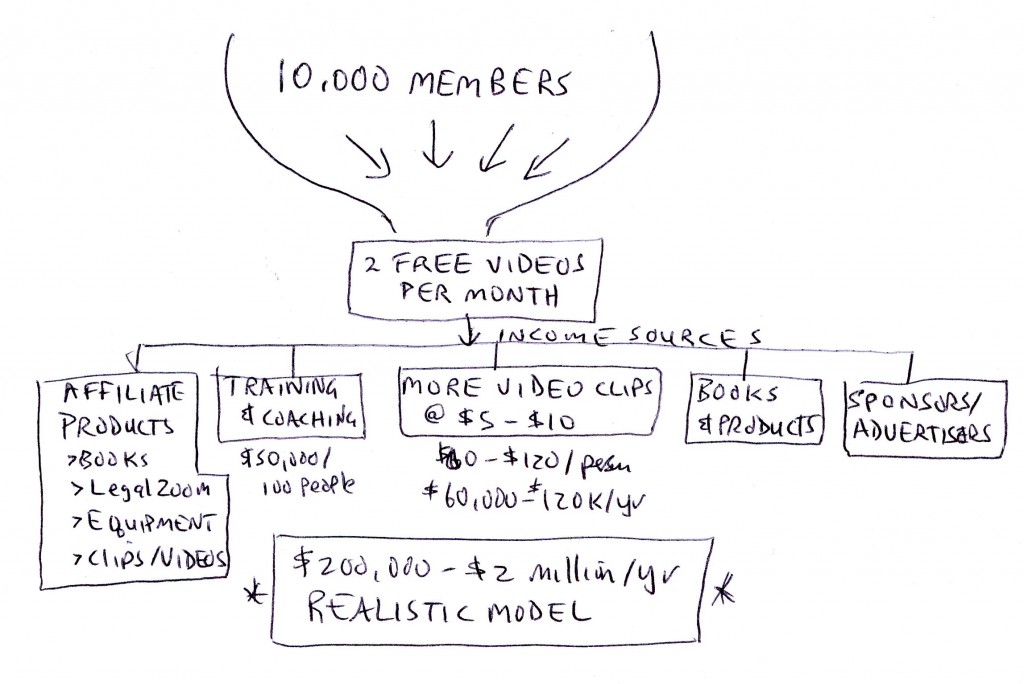 There’s a powerful secret many successful businesspeople don’t want you to know, that may make the difference between your making truckloads of money and spending years struggling to get by.
There’s a powerful secret many successful businesspeople don’t want you to know, that may make the difference between your making truckloads of money and spending years struggling to get by.
What’s the number one mistake most people make, that limits their ability to make money?
It’s using basically the same business model as your competitors, rather than designing one that takes advantage of your unique strengths and resources.
That may sound like a mouthful, but the implications for you can be profound.
Your business model is how you make money, your pricing and payment plans, your differentiation (what makes you different from competitors) and what you actually offer to customers.
Selecting the wrong business model could set you up for only moderate success or worse… years of struggle, while selecting the right model could transform a moderate success into an engine of profit and growth.
Here, let me show you an example.
The other day I was chatting with Andy, a videographer laid off from Warner Bros., who is trying to create an online video clips website. While he was looking at a website called VideoBlocks.com, he got inspired, thinking he could do a much better job than they have done.

Explaining that he’s already created almost 4,000 great video clips that he could offer on his site, he felt by offering a $70-per-month membership, with a limited number of downloads each member could make per month, he’d win plenty of subscribers.
To me, that seemed unrealistic. Here’s why…
First, the site he mentioned (see the example above) claims to have more than 50,000 clips. That’s more than ten-times the number of clips Andy has available. And they’re charging the same $70-a-month that Andy wants to charge. Plus, they have NO limit to the number of clips a member could download each month.
Also, their site has tremendous credibility. They claim more than 6 million client downloads have been made thus far, listing ABC, NBC, History Channel and other top media companies among their more-than 90,000 supposed customers.
They’ve also won numerous awards and recommendations, from Inc. Magazine listing them as the #4 fastest growing media company, to major magazines touting their high value.
Plus… they have plenty of cash. Besides income from members and buyers, they’ve raised millions in venture funding.
Competing head-to-head with a company like this is tough, especially when you’re only offering a fraction of what they offer, and with a fraction of their credibility. Going head-to-head with them seems an unnecessarily tough uphill battle, especially when there are so many creative ways to establish a competitive edge right from the start.
Competing with McDonald’s restaurants, Burger King offered something different… flame broiled burgers rather than fried, that you could get prepared any way you’d like it (Have it your way). This provided customers with an attractive alternative rather than a weak me-too product.
And that’s something Andy sorely needs if he wants to make real money—a clear attractive differentiator.
Start By Defining Your Ideal Target Customer
Andy, like most entrepreneurs, instinctively tried to copy his competitor. But that’s a ticket to mediocrity and poverty. A much better approach begins with defining what specific outcome you want.
So ask yourself this question… Once you start becoming successful, what will your business look like?
I’ve found that putting a simple number to a goal like this really helps. For Andy, once he gets 10,000 subscribers, his business will really be booming.
There, I’ve said it. I’ve put a simple tangible target on the table. 10,000 members.
Now that we have a specific goal of how many members we want, we need to define who exactly they will be. Andy and I identified three types of potential customers:
1. Onesies… people who only want just one or two clips, and that’s it. These people are generally amateurs hoping to make videos, but probably won’t stick with it.
2. Amateur videographers… people starting out or with limited video knowledge and expertise, but interested in creating ongoing videos, for themselves or for clients. These people are interested, not just in video clips, but in mentorship and training, so they could improve their skills and make more money.
3. Professional videographers… this includes people like Andy, who make an ongoing living creating videos for commercials and the Internet. These people generally have the most money to spend, but also have their established sources.
In evaluating the three types of potential clients, I decided the first group, the onesies, are not worth concentrating on because they would be the least profitable.
Andy wanted to focus on the third group, the pros, but I felt the second group could offer the greatest opportunity to build a large dedicated membership base. These amateur videographers will want video clips, but they would also appreciate plenty of help.
These people would be more open to trying stuff Andy suggests, whereas the pros would more likely be set in their ways. Also, there should be significantly more amateur videographers than professional ones.
Most importantly, by concentrating on the second group, the amateur videographers, if Andy’s offerings are good enough, he should also attract pros into the membership list. So concentrating on the amateurs could bag him both groups.
Therefore, it was decided that Andy would build the website to appeal to Amateur Videographers.
Next, Leverage Your Unique Resources
Once we knew WHO exactly we wanted to attract, now we needed to decide what to offer them so they’d want to become members of Andy’s site.
To come up with an answer, we reviewed Andy’s main assets.
He had 4,000 great video clips, and the credibility of the Warner Bros. name that he could probably use somehow on the site.
But Andy also had himself—meaning, he personally could provide ongoing tips and guidance, maybe even evaluate people’s videos, on a recorded webinar that he could later share on his website.
Okay. So now that we understand what Andy has to work with—the videos, the Warner Bros. name and Andy himself. How could we use that to get 10,000 members to sign up?
As part of the brainstorming process, for a moment let’s consider money to not be an issue. If Andy didn’t care about money, how could he use these video clips and other resources to attract 10,000 members?
What if he offered all his video clips for free?
Would videographers agree to giving Andy their email address in exchange for getting FREE access to Andy’s amazing video clips?
I think the answer is a definite YES …and this could easily become the seed of a powerful and lucrative business model.
What if Andy offers 2 free videos-a-month when you become a member?
Then, let’s say he charges $5 or $10 for every video above those initial two. After all, most active videographers will probably use more than 2 clips-a-month, won’t they? And even if they don’t, Andy will at least have their contact info so he’ll be able to try and sell them more stuff later.
For those members wanting more than two clips-a-month, he could earn $60-$120-a-year from everyone who buys just one or two additional video clips-a-month.
Plus, if Andy’s clips truly are that great, these members may buy even more.
So, with this simple business model, Andy could now have a rapidly growing database of active videographers, plus real money flowing in.
For all the people in his database, he could then offer books, products and training programs designed specifically for their needs and interests. These could be created by Andy or could be affiliate products, where he receives a finder’s fee for every one sold.
Using affiliate products, he could sell cameras, video equipment and books from Amazon.com for about 12% commission; incorporation, copyright and other legal services from LegalZoom.com; audio and video clips from other stock-image sites, and more.
Andy could also offer personalized or group training and coaching—perhaps a 6-week coaching program, including personal evaluation of a student’s videos for, say, $500 or more.
That’s $50,000 for every 100 people he signs up, and it only requires a one-hour-a-week phone or webinar commitment (perhaps using FreeConferenceCall.com or another free or low cost service), plus some review and prep time. After the first group, he could pretty well follow the same agenda for every subsequent group, making this a no-brainer once the first group has finished its 6-week run.

The True Benefit of a Personalized Business Model
Are you starting to understand how much better it is for Andy, as it is for you to design a personalized business model rather than simply following the model of his major competitor?
For Andy, suddenly he has a realistic opportunity to quickly win more than 10,000 members for his new service.
Of course, he’ll still need to market to videographers and web developers—letting thousands of them know he exists.
I explain how to do this in much more detail in my all-new video marketing program —
5-Minute-Marketing (http://5-Minute-Marketing.com).
But for now, even if you are effective in reaching potential customers, with the wrong offer and business model, your chance for success will be greatly limited or even impossible.
If you can create a business model that focuses on a single specific tangible goal, targets your best most lucrative customers and leverages the assets and resources you have, especially if you can do this in a way that gives you a competitive advantage, this could provide you a real opportunity to generate major income with minimal effort and expense.
Try it. You won’t believe how powerful this could be, in helping you uncover an easier way to build a successful business.


